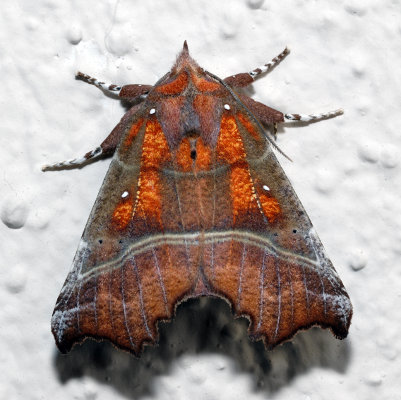Découpure : Différence entre versions
m (A déprotégé « Découpure ») |
m (A déprotégé « Découpure ») |
||
| (5 révisions intermédiaires par le même utilisateur non affichées) | |||
| Ligne 1 : | Ligne 1 : | ||
[[Category:Insectes]] | [[Category:Insectes]] | ||
| − | <br> | + | [[Image:Scoliopteryx libatrix.jpg|Image:Scoliopteryx_libatrix.jpg]]<br> Découpure ''Scoliopteryx libatrix'' |
| − | |||
====== Etymologie ====== | ====== Etymologie ====== | ||
| − | + | *'''Nom latin''' : ''Scoliopteryx libatrix'' | |
| − | + | *'''Nom anglais''' : The Herald | |
| − | + | *'''Famille''' : '''Noctuidae'''. | |
====== Description ====== | ====== Description ====== | ||
| − | + | *'''Taille''' : 40-45 mm | |
| − | + | *Noctuelle colorée aux ailes découpées. | |
| − | + | ====== Plantes hôtes ====== | |
| + | *Chenille sur saules ''Salix'' sp. et peupliers ''Populus'' sp. | ||
====== Répartition ====== | ====== Répartition ====== | ||
| − | + | *'''Europe''', Asie, Afrique du Nord, Amérique du Nord. | |
| − | + | ====== Habitat ====== | |
| − | + | *'''Milieux humides''', berges des cours d'eau, bords des tourbières et marécages et aussi dans les jardins, parcs, lieux incultes. | |
| − | ====== Habitat | + | ====== Ecologie ====== |
| − | + | *Hiverne à l'état adulte, de ce fait est l'une des dernières espèces d'hétérocères à être observée en automne et l'une des première en fin d'hiver. | |
| − | |||
| − | |||
| − | |||
| − | |||
| − | |||
| − | |||
| − | ====== | ||
| − | |||
| − | |||
| − | |||
====== Statut ====== | ====== Statut ====== | ||
| − | + | *Pas de statut de protection connu. | |
| − | + | ====== Bibliographie ====== | |
| − | + | *Bebbington John & Lewington Richard (2007) - '''Guide to the hawkmoths of the British Isles'''. Edition Field Studies Council (FSC). | |
| − | ====== | + | *Leraut Patrice (2006) - '''Papillons de nuit d'Europe, bombyx, sphinx, écailles...''' VOL I. NAP éditions. |
| − | + | *Leraut Patrice (2009) - '''Papillons de nuit d'Europe, géomètres''' VOL II. NAP éditions. | |
| − | --- | + | *Lewington Richard (2006) - '''Guide to the day-flying moths of Britain'''. Edition Field Studies Council (FSC) |
| + | *Manley Chris (2008) - '''British moths and butterflies, a photographic guide'''. Edition A & C Black. | ||
| + | *Robineau Roland (2007) -'''Guide des papillons nocturnes de France''', plus de 1620 espèces décrites et illustrées. Edition Delachaux & Niestlé. | ||
| + | *Skinner Bernard (2009) -'''Colour identification guide to moths of the British isles'''. Edition Apollo Books. | ||
| + | *Townsend M. & Waring P. (2007) -'''Concise guide to the moths of great Britain and Ireland'''. Edition British Wildlife Publishing | ||
| + | *Waring Paul & Townsend Martin (2009)- '''Field guide to the moths of great Britain and Ireland'''. Edition British Wildlife Publishing. | ||
| + | *Young Mark (1997) -'''Natural History of Moths'''. Edition T & AD Poyser Ltd (A & C Black). | ||
Version actuelle datée du 22 septembre 2015 à 16:10

Découpure Scoliopteryx libatrix
Sommaire
Etymologie[modifier]
- Nom latin : Scoliopteryx libatrix
- Nom anglais : The Herald
- Famille : Noctuidae.
Description[modifier]
- Taille : 40-45 mm
- Noctuelle colorée aux ailes découpées.
Plantes hôtes[modifier]
- Chenille sur saules Salix sp. et peupliers Populus sp.
Répartition[modifier]
- Europe, Asie, Afrique du Nord, Amérique du Nord.
Habitat[modifier]
- Milieux humides, berges des cours d'eau, bords des tourbières et marécages et aussi dans les jardins, parcs, lieux incultes.
Ecologie[modifier]
- Hiverne à l'état adulte, de ce fait est l'une des dernières espèces d'hétérocères à être observée en automne et l'une des première en fin d'hiver.
Statut[modifier]
- Pas de statut de protection connu.
Bibliographie[modifier]
- Bebbington John & Lewington Richard (2007) - Guide to the hawkmoths of the British Isles. Edition Field Studies Council (FSC).
- Leraut Patrice (2006) - Papillons de nuit d'Europe, bombyx, sphinx, écailles... VOL I. NAP éditions.
- Leraut Patrice (2009) - Papillons de nuit d'Europe, géomètres VOL II. NAP éditions.
- Lewington Richard (2006) - Guide to the day-flying moths of Britain. Edition Field Studies Council (FSC)
- Manley Chris (2008) - British moths and butterflies, a photographic guide. Edition A & C Black.
- Robineau Roland (2007) -Guide des papillons nocturnes de France, plus de 1620 espèces décrites et illustrées. Edition Delachaux & Niestlé.
- Skinner Bernard (2009) -Colour identification guide to moths of the British isles. Edition Apollo Books.
- Townsend M. & Waring P. (2007) -Concise guide to the moths of great Britain and Ireland. Edition British Wildlife Publishing
- Waring Paul & Townsend Martin (2009)- Field guide to the moths of great Britain and Ireland. Edition British Wildlife Publishing.
- Young Mark (1997) -Natural History of Moths. Edition T & AD Poyser Ltd (A & C Black).